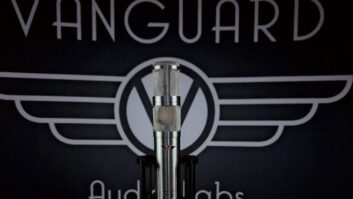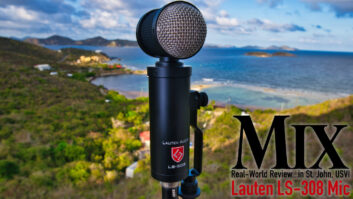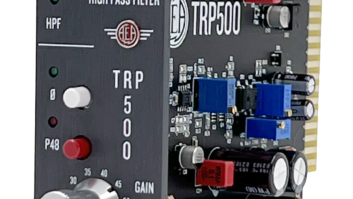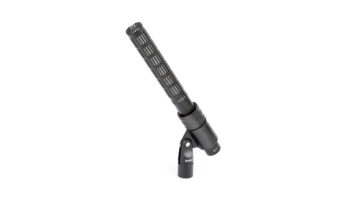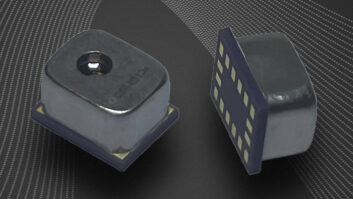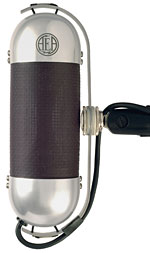

What? Another great affordable ribbon mic to put in the locker? And you don’t have to click your heels three times and make a wish to get it? The Audio Engineering Associates R92 is the latest outing from Wes Dooley and it’s remarkable. Finished in space-age anodized aluminum and fixed in an integral shock-mount with attached cable, the R92 looks and feels as stylish and solid as the R84 and R88 — the two previous AEA efforts that share the R92’s engine.
Although its ribbon pedigree is similar to its cousins, the R92 is truly a different mic, featuring a reduced proximity boost and some extended top end. The mic is only about -2 dB at 10 kHz, whereas its forefathers were down some -5 dB. The reduced bass boost at close range makes this a winner for vocals, narration duties and other “intimate” work. The cost of this tailored response means less overall output, but when paired with a quiet preamp with plenty of gain, it’s not a problem. As with other AEA mics, the front and back of the mic have different personalities; in this case, the front being the “crisp” side and the back exhibiting a more traditional ribbon smoothness and roll-off.
LET’S CUT TO THE CHASE
I first heard the R92 used on a male lead vocal. It was sent through an SSL 4000 Series mic preamp and flat to tape. The mic is well protected by the stylish outer skin, but being a bit paranoid about the ribbon, I used a windscreen. The reduced bottom end and extended top was evident. While not in-your-face with “air,” I could still sense the extra detail. Even without compression, the vocal sat nicely in the mix, and the ribbon’s tendency to round out the rough transient edges made it a winner for this application. Even though you will need to add some top for the final mix, this mic really brings something to the table when used for vocals.
Next, I used the R92 as the center mic in an LCR array over a drum kit through the new Universal Audio 8110 mic preamps. I was happy to see that this preamp nicely has a 2k setting for input impedance and plenty of gain — a great match for any ribbon. I lined it up about two feet over the cymbals along with two vintage AKG 451E cardioid microphones on the left and right. The 451Es are naturally (and beautifully) bright and are among my favorites when used as a stereo pair over a kit. The R92’s signature couldn’t be more different. As expected, it sounded noticeably dark, but was a nice addition to the center image.
What the R92 does to transients is a thing of beauty. The snare’s snap was wonderfully rounded, giving a compressed sound that only a ribbon can. As the snare is set up to the left of the kick, overheads can drag the image to the left, but when panned center and added to the left and right spaced mics, the R92 sat the snare down in the middle of the mix. In addition, it didn’t compete or detract from the 451Es; it was just “there” where you needed it, doing its thing very well.
Next was the R92 on a guitar cabinet, about a foot from the speaker. The mic’s ability to handle 135dB SPLs makes it perfect for this application. Also, the rear of the ribbon gave a bit of the room to the sound. The amp was placed behind a gobo and near a corner of the room. The track started with the guitar set at a clean sound with some punctuated chords played with the ensemble. The ribbon rounded out the punchy chords and added a nice lush tone to the track. When the guitarist kicked in the overdrive for the solo section, the R92 didn’t flinch, handling the extra level and making the solo sing.
Soprano saxophone can be an “edgy” instrument, but not so with the R92. Placed about a third of the way up the horn from the bell, with the ribbon in the vertical position, the mic laid a silky blanket over the sound, especially when the player went for upper-register staccato notes. The solo sat squarely in the track and hit the reverb perfectly. Even with the fader in a static position, it fit in with the rest of the ensemble.
IT’S RIBBON-LICIOUS
I’m a pushover for ribbon mics. They are uniquely qualified to bring warmth and pleasure to almost any sound source. With the R92, the extended top and reduced bottom brings something completely new to the mix. And although it sounds decidedly dark when compared to a condenser, it more than makes up for it with personality.
It rounds off transients in true ribbon fashion, adding a naturally compressed sound that flatters even the most strident source. This tendency and its tailored frequency response make the R92 a hands-down winner at close quarters. You don’t need to be afraid to get this mic in a singer’s face or right up on a speaker. The R92 — like its forefathers carrying the same engine, the R84 and R98 — is unequaled in its price range. I almost felt guilty getting this kind of quality for $900. Well, not that guilty! Wes Dooley and the AEA crew have done it again.
Audio Engineering Associates, 626/798-9128, www.wesdooley.com.
Kevin Becka is Mix’s technical editor.

Click here to see a graph of the R92’s response curves, and to download a product manual and full technical specs.
Read all about ribbon mics, including AEA founder Wes Dooley’s take, here.


